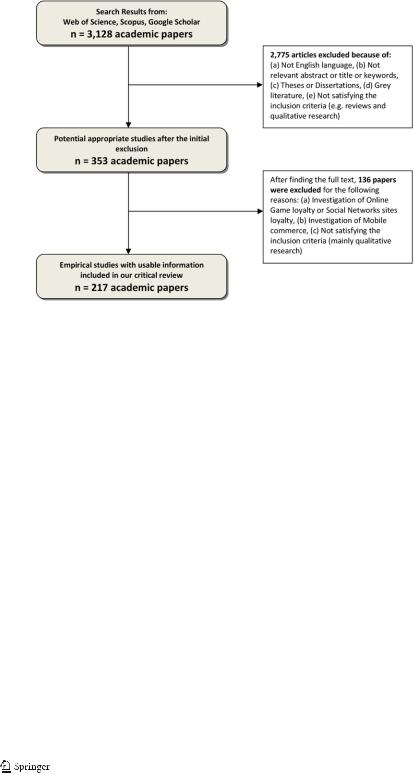
e-loyalty
.pdf
Electron Commer Res (2012) 12:331–378
DOI 10.1007/s10660-012-9097-5
Critical review of the e-loyalty literature: a purchase-centred framework
Aikaterini C. Valvi · Konstantinos C. Fragkos
Published online: 18 August 2012
© Springer Science+Business Media, LLC 2012
Abstract Over the last few years, the concept of online loyalty has been examined extensively in the literature, and it remains a topic of constant inquiry for both academics and marketing managers. The tremendous development of the Internet for both marketing and e-commerce settings, in conjunction with the growing desire of consumers to purchase online, has promoted two main outcomes: (a) increasing numbers of Business-to-Customer companies running businesses online and (b) the development of a variety of different e-loyalty research models. However, current research lacks a systematic review of the literature that provides a general conceptual framework on e-loyalty, which would help managers understand their customers better, take advantage of industry-related factors, and improve their service quality. The present study is an attempt to critically synthesize results from multiple empirical studies on e-loyalty. Our findings illustrate that 62 instruments for measuring e-loyalty–with two or more items—are currently in use, influenced predominantly by Zeithaml et al. (J. Marketing 60(2):31–46, 1996) and Oliver (Satisfaction: a behavioral perspective on the consumer. New York: McGraw Hill, 1997). Additionally, we propose a new general conceptual framework, which leads to e-loyalty dividing antecedents into prepurchase, during-purchase and after-purchase factors, based on the act of purchase. To conclude, a number of managerial implementations are suggested
Electronic supplementary material The online version of this article (doi:10.1007/s10660-012-9097-5) contains supplementary material, which is available to authorized users.
A.C. Valvi ( )
Department of Management, Birkbeck, University of London, London, UK e-mail: a.valvi@bbk.ac.uk
A.C. Valvi
e-mail: valvikaterina@gmail.com
K.C. Fragkos
Department of Economics, Mathematics and Statistics, Birkbeck, University of London, London, UK e-mail: kfragk01@mail.bbk.ac.uk

332 |
A.C. Valvi, K.C. Fragkos |
|
|
in order to help marketing managers increase their customers’ e-loyalty by making crucial changes in each purchase stage.
Keywords E-loyalty · E-satisfaction · E-trust · Customer behaviour · E-commerce · Critical review · Framework
1 Introduction: loyalty in the Internet era
The penetration of the Internet in marketing and e-commerce settings has influenced, to a great extent, the entire business world. From the customer’s viewpoint, it has created new and possibly less costly ways of participating in commercial activities [182]. From the business perspective, market globalization, along with the decreasing effectiveness of offline marketing, has motivated organizations to shift their plans to include Internet marketing [120]. Hence, consumers have increasingly favored online shopping [166], gradually leading more Business-to-Customer (B2C) companies to establish an Internet presence in an effort to attract new and maintain existing customers for long-term profitability [203].
Building and maintaining brand loyalty has been a central theme of marketing theory and practice in traditional consumer marketing [71]. For this reason, businesses should be more interested in keeping long-lasting relationships with their customers than in accumulating occasional exchanges [17]. Presently, the notion of brand loyalty has been expanded to include online loyalty (also known as e-loyalty or website loyalty). The online shopping world has completely changed the relationship between customers and retailers. The minimal cost to a customer to switch brands (compared to the high costs for companies to acquire new e-customers) justifies the need for online businesses to create a loyal customer base, as well as to monitor the profitability of each segment in order to avoid unprofitable customer relationships during the initial years of online operation [7, 166, 167]. Moreover, Reichheld et al. [163, 164] and Day [51] have indicated that the notion of e-loyalty is the most important factor affecting online business performance.
E-loyalty is “the customer’s favorable attitude towards an electronic business, resulting in repeat purchasing behaviour” [7]. It encompasses high quality customer support, on-time delivery, compelling product presentations, convenient and reasonably priced shipping and handling, and clear and trustworthy privacy policies [166]. As a result, the study of e-loyalty’s antecedents has become essential [161]; satisfaction, trust, service quality, and perceived value among others are certain precursors.
Consequently, creating customer loyalty and satisfaction is the major objective for online companies to increase profitability and obtain and maintain competitive advantage. To do so, companies need to develop a thorough understanding of the antecedents of loyalty on the World Wide Web [120]. Shankar et al. [181, p. 154] note that “firms need to gain a better understanding of the relationship between satisfaction and loyalty in the online environment to allocate their online marketing efforts between satisfaction initiatives and loyalty programs”. Reichheld and Sasser [165] suggested that increasing a business’s number of loyal customers by 5 % can result in a 30 % to 85 % increase in profitability. However, the identification of factors that might affect e-loyalty has puzzled academic scholars over the last decade [189, 195].

Critical review of the e-loyalty literature: a purchase-centred framework |
333 |
|
|
2 Purpose
No problem facing the individual scientist today is more defeating than the effort to cope with the flood of published scientific research, even within one’s own narrow specialty.
Bentley Glass [70, p. 583]
Up to this point, various studies have tried to explain the concepts of loyalty and satisfaction in online markets as well as the potential factors that influence them [37, 154, 197]. However, many online companies fail to cultivate e-loyalty because they are not aware of the mechanisms involved in generating customer loyalty on the Internet [169]. To the best of our knowledge, and despite the importance of e- loyalty for a business’s success in the online market, there is a lack of comprehensive and systematic reviews on e-loyalty that incorporate empirical results from the last decade.
Hence, the purpose of this study is to concentrate all the available empirical literature on e-loyalty as studied in e-commerce settings and to answer the following questions:
(1)What instruments are currently available to assess e-loyalty?
(2)Is there a common definition of e-loyalty? What are considered to be its most widely accepted antecedents?
(3)What are the limitations of current research in the e-loyalty literature?
3 Methodology
3.1 Literature search
The literature review was conducted sourcing the following electronic databases: Web of Science, Scopus, Business Source Premier, ABI Inform, and Google Scholar. Search terms included different combinations of “e-loyalty”, “web loyalty”, “online loyalty”, “web”, “e-commerce”, “intentions”, and “repurchase intentions”. Searches extended until July 2011 with no cut-off date for past studies. Only articles written in English were included. Articles could be from conference proceedings or journals, but only records with available abstracts were included. Dissertations, theses, and other material from the “grey literature” were excluded [170, 208]. We included studies that satisfied the following criteria: (a) They were sampling or experimental surveys and reported quantitative results and (b) They had e-loyalty as a dependent variable in the model the paper tested. Qualitative studies were excluded due to the present review’s interest in instruments used for measuring e-loyalty and their psychometric properties. Methodologically, a critical review of qualitative studies assesses different concepts (e.g., sampling, coding, etc.) than one of quantitative studies, while qualitative studies are predominantly theory building and not theory testing essays [53]. Our aim is to offer an evidence-based approach for all research questions based on tested theories.

334 |
A.C. Valvi, K.C. Fragkos |
|
|
Fig. 1 Literature search results
Our search method also resulted in papers that investigated loyalty in mobile commerce (m-commerce) settings, loyalty towards social networking sites and online gaming platforms, and certain attitudes towards websites. These papers were excluded, since papers studying loyalty behaviors in e-commerce and marketing settings were the primary interest.
The next step in the data collection process involved a type of snowball sampling technique: the references listed in the obtained studies were used to locate additional studies [80, 154]. Also, major review papers were screened for references to ensure that all suitable papers were included. Our search method resulted in 3,128 academic papers, which were downsampled to 217 according to the inclusion criteria. The screening procedure is shown in Fig. 1.
3.2 Academic papers
The papers included in our sample came mainly from the marketing and e-commerce settings of various industries (book selling websites, travel websites, general retailing websites, etc.). The total sample size, taken from all studies, was 103,858 people. The first papers discussing some aspect of e-commerce loyalty appeared in 1998 and, following a steady increase from 2003 to 2008, articles peaked at 120 to 140 in 2009 and 2010 (Fig. 2). Many papers from 2011 were still in publication, but given the present review’s time limit and the fact that the number of papers up until that point equaled about half of 2010’s total number, a figure of about 140 is expected for 2011. This shows the ongoing interest of academic researchers for studying e-loyalty in e- commerce settings. From the Web of Science sample of papers on e-loyalty (590),

Critical review of the e-loyalty literature: a purchase-centred framework |
335 |
|
|
Fig. 2 Articles mentioning e-loyalty, web loyalty or online loyalty from Web of Science and Scopus
most papers published are authored by researchers from the USA (31.4 %), Taiwan (16.1 %), China (14.3 %), South Korea (6.1 %), and the UK (8.2 %); the remaining studies are from various other European, Asian, and American countries.
3.3 Synthesis of the literature
Several steps were followed in the process of synthesizing the concepts presented in various studies and the impact they have had on e-commerce literature [234]. A table of all studies was created, noting the following information for each study: authors and year of publication, main area of study, scope of the paper, sample size, loyalty instrument used, number of items and Likert points, the instrument’s reliability, and results of its confirmatory factor analysis. For each study, we noted the other dimensions/concepts measured by authors and results of their hypotheses concerning e-loyalty. Finally, the number of citations each paper received from Google Scholar and an impact ratio (citations in Google Scholar/year) were included to assess the relative impact of each paper [37]. A detailed list of all papers identified is included in the Supplementary Appendix (Table A2). As a next step, we identified the instruments used for studying loyalty in e-commerce settings and constructed a unifying model of all of the studies’ results.
4 Critical assessment of e-loyalty instruments
4.1 Overview of e-loyalty instruments
A useful starting point in assessing the e-loyalty literature is identifying general trends across existing e-loyalty instruments. These questionnaires consist of a series

336 |
A.C. Valvi, K.C. Fragkos |
|
|
of questions for the purpose of gathering information from respondents. Our search process resulted in noting 62 e-loyalty instruments with a number of items ranging from two to 16 (either on 5-point or 7-point Likert scales) and eight one-item instruments, outlined in Tables 1, 2, and 3, mentioning the information for each paper gathered from the literature search. Out of the 62 instruments, 23 were self-defined by authors and 39 were adaptations from previous loyalty or e-loyalty instruments.
The instruments are listed in chronological order in Tables 1, 2, and 3 with the instrument by Lynch et al. [123] being the earliest one-item instrument; that of Devaraj et al. [54] is the earliest self-defined instrument and Gefen and Straub’s [69] is the earliest adapted loyalty instrument. A certain number of the instruments are used more frequently than others, but most of them are unknown (as indicated by the small number of citations). A possible explanation for this is that authors might find many similarities between the least-cited and most-cited instruments, thus selecting the more popular ones even when they consider parts of them irrelevant. The surveys were created by researchers in a variety of disciplines, including e-commerce, business, marketing, and information science, suggesting that e-loyalty is a complex field that has drawn attention from multiple disciplines. The number of items per instrument ranged from one to 16. More than 100 factors or dimensions were measured, depending on the hypotheses made by the authors in their studies, and more than 33 factors were found to have some significant association with e-loyalty.
The impact ratio (IR) of each paper was also examined; it ranged from 0 [128] to 95.5 [108], with mean IR = 4.1. The impact ratio controls for year so it clearly depicts the impact of each instrument independent of its year of publication [37]. According to their IR, the most important papers describing a new e-loyalty instrument are those by (a) Koufaris [108] (IR = 95.5) and Shankar et al. [181] (IR = 50.6) among the one-item instruments; (b) Yen and Gwinner [225] (IR = 10.4) and Vatanasombut et al. [206] (IR = 9.3) among the self-defined instruments; and (c) Srinivasan et al. [189] (instrument use by subsequent authors: 40 times) and Gefen and Straub [69] (instrument use by subsequent authors: 16 times) among the adapted instruments. From the adapted instruments, the study by Zeithaml et al. [233] appears to have significantly influenced e-loyalty literature, as 49 authors have adapted this instrument to measure e-loyalty. Second comes Oliver [143–145], whose customer satisfaction theories have been used as a basis to form an e-loyalty instrument in 11 studies.
4.2Starting points for e-loyalty instruments: Zeithaml et al. [233] and Oliver [143, 144]
It is worth analyzing the properties of the instruments with the greatest conceptual influence, namely those of Zeithaml et al. [233] and Oliver [143, 144]. Zeithaml et al. [233] offered a conceptual model of the impact of service quality on particular behaviors that signaled whether customers remain with or defect from a company (loyalty or disloyalty). Their methodological approach resulted in a configuration of five items for loyalty, which had high internal consistency (0.93 to 0.94 across companies). These loyalty items stressed the importance of recommending a company to others, through positive words, advice, and friendly encouragement, or through repetitive behaviors of continuing to patronize a business over the next years and

Table 1 One-item e-loyalty instruments. Confirmatory factor analysis was not done on these measures and reliability cannot be measured for one-item instruments
No. |
Reference |
Sample size (N ) |
Likert points |
Other dimensions measured |
IR |
|
|
|
|
|
|
1 |
Lynch et al. [123] |
299 |
7 |
Trust, Affect, Site Quality |
17.4 |
2 |
Koufaris [108] |
280 |
7 |
Product Involvement, Web Skills, Value-Added Search Mechanisms, |
95.5 |
|
|
|
|
Challenges, Perceived Control, Shopping Enjoyment, Concentration, |
|
|
|
Data set 1: N = 144; Data set 2: |
|
Perceived Usefulness, Perceived Ease of Use |
|
3 |
Shankar et al. [181] |
7 |
Online Medium, Service Encounter Satisfaction, Overall Satisfaction |
50.6 |
|
|
|
(online sample) N = 190; |
|
|
|
|
|
Data set 3: (offline sample |
|
|
|
|
|
unmatched) N = 403 |
|
|
|
4 |
Kim and Kim [104] |
303 |
7 |
Demographics (gender, age, income, education, number of children), |
7.3 |
|
|
|
|
Transaction/Cost, Incentive Programs, Site Design, Interactivity |
|
5 |
Jiang and Rosenbloom [95] |
The study includes 416 e-tailers |
10 |
Customer Price Perception, Customer Satisfaction at Check-out, |
11.5 |
|
|
with over a quarter of a million |
|
Customer Satisfaction after Delivery, Overall Customer Satisfaction |
|
|
|
individual consumer respondents |
|
|
|
6 |
Mithas et al. [130] |
More than 12,000 customers |
10 |
Web site structure, Web site content, Web site functionality, |
13 |
|
|
across 43 Web sites |
|
Government vs. Commercial domain – Physical goods vs. services |
|
|
|
|
|
domain, Information richness domain, Transaction richness domain |
|
7 |
Castañeda et al. [30] |
103 |
5 |
8 |
Abdul-Muhmin [1] |
436 |
7 |
Attitudes toward Internet use, Brand, Website, Satisfaction |
3 |
Satisfaction with: Online Product Prices, Delivery Time, Delivery |
0 |
Cost, Online Product Quality, Online Customer Service, Required Online Payment Method, Online Payment Security, Overall Satisfaction with previous Online Purchase, Attitudes toward Online Purchase
Note: IR, Impact Ratio
framework centred-purchase a literature: loyalty-e the of review Critical
337

Table 2 Twenty three self-defined e-loyalty instruments
No. |
Reference |
N |
No. of Items |
Reliability |
Fit Indices (if CFA |
Other dimensions measured |
IR |
|
|
|
(Likert points) |
|
Performed) |
|
|
|
|
|
|
|
|
|
|
1 |
Devaraj et al. [54] |
134 |
4(7) |
NR |
NR |
Efficiency (Time, Ease-of-use, Effort), |
3.4 |
|
|
|
|
|
|
Value (Price, Quality), Interaction |
|
|
|
|
|
|
|
(Information, Safety, Load Tine, |
|
|
|
|
|
|
|
Navigation), Purchase Decision |
|
2 |
Yen and Gwinner [225] |
459 |
2(7) |
Reliability |
CFA not done |
Perceived Control, Performance, |
10.4 |
|
|
|
|
coefficient: 0.85 |
|
Convenience, Efficiency, Confidence |
|
|
|
|
|
|
|
Benefits, Special Treatment Benefits, |
|
|
|
|
|
|
|
Satisfaction |
|
3 |
Thatcher and George [200] |
441 |
2(NR) |
Complete reliability |
CFA not done. EFA was |
Positive Affect (Aesthetics, Entertainment), |
4.3 |
|
|
|
|
(ICR): 0.930 |
executed |
Commitment (Learning Costs, Transaction |
|
|
|
|
|
|
|
Costs, Artificial Costs), Customer |
|
Satisfaction (Pricing, Convenience,
Selection), Trust - Social Involvement
Commitment Interaction
4 |
Lim and Dubinsky [116] |
237 |
2(7) |
Cronbach’s α: 0.90 |
Acceptable model fit: |
|
|
|
|
|
χ 2 = 236.07, df = 188, |
|
|
|
|
|
RMSEA = 0.029 |
5 |
Olson and Boyer [148] |
242 |
2(7): Web site |
Web site |
CFA not done |
|
|
|
attractiveness |
attractiveness: 0.57 |
|
|
|
|
5(7): Internet |
Internet |
|
|
|
|
improvement |
improvement: 0.86 |
|
6 |
Hackman et al. [78] |
171 |
3(7) |
Composite |
CFA not done |
|
|
|
|
reliability: 0.874 |
|
7 |
Park and Kim [153] |
213 |
3(5) |
Cronbach’s α: 0.83 |
CFA not done |
Self-efficiency, Facilitation of ability, |
4.2 |
Family, Friends, Merchandise, Reliability, |
|
Navigation, Perceived Behavioral Control, |
|
Subjective Norm, Attitude toward online |
|
shopping |
|
Patron Factors (Patron Strategy and |
1.5 |
Website Interaction), Technological Factors |
|
(Website Functionality) |
|
Sacrifice, Online Service Quality, Online |
3.2 |
Service Value, Online Service Satisfaction |
|
Perceived time risk, Perceived consumption |
1 |
delay, Attitude toward the Web site |
|
338
Fragkos .C.K Valvi, .C.A

Table 2 |
(Continued) |
|
|
|
|
|
|
|
|
|
|
|
|
|
|
No. |
Reference |
N |
No. of Items |
Reliability |
Fit Indices (if CFA |
Other dimensions measured |
IR |
|
|
|
(Likert points) |
|
Performed) |
|
|
|
|
|
|
|
|
|
|
8 |
Wang and Head [210] |
177 |
2(7) |
Cronbach’s α: 0.63 |
9 |
Huang [89] |
269 |
18(5) |
Cronbach’s α: 0.81 |
10 |
Lin et al. [118] |
590 |
3(7) |
Construct |
|
|
|
|
reliability: 0.779 |
Acceptable model fit: |
Exogenous constructs (Perceived |
7.75 |
Exogenous constructs: |
Consumer Power, Perceived Relationship |
|
χ 2 = 45.2, df = 38, |
Investment, Perceived Interaction, |
|
χ 2/df = 1.2, p = 0.20, |
Perceived Shopping Risks), Endogenous |
|
GFI = 0.96, |
constructs (Perceived Switching Costs, |
|
AGFI = 0.92, |
Satisfaction, Trust) |
|
CFI = 0.99, |
|
|
RMSEA = 0.03 |
|
|
Endogenous constructs:
χ2 = 32.2, df = 21,
χ2/df = 1.5, p = 0.06,
GFI = 0.96,
AGFI = 0.92,
CFI = 0.99,
RMSEA = 0.06
Acceptable model fit: |
E-quality (price benefits, useful |
2.3 |
χ 2/df = 1.18, p = 0.09, |
information, customization, interactivity, |
|
GFI = 0.95, |
accessible business process, |
|
AGFI = 0.92, IFI = 1, |
responsiveness), Trust (promise fulfillment, |
|
CFI = 1, NFI = 0.98, |
company reputation, transaction |
|
RMR = 0.04, |
confidentiality, professional ability belief, |
|
RMSEA = 0.03 |
benevolence belief) |
|
Acceptable model fit |
Incentive, Confirmation, Satisfaction, Trust |
0 |
framework centred-purchase a literature: loyalty-e the of review Critical
339

Table 2 |
(Continued) |
|
|
|
|
|
|
|
|
|
|
|
|
|
|
No. |
Reference |
N |
No. of Items |
Reliability |
Fit Indices (if CFA |
Other dimensions measured |
IR |
|
|
|
(Likert points) |
|
Performed) |
|
|
|
|
|
|
|
|
|
|
11 |
Ma et al. [124] |
266 |
NR(6) |
Cronbach’s α: |
Acceptable model fit: |
Content, Convenience Communication, |
0 |
|
|
|
|
0.60–0.88 |
Model 1: χ 2 = 718.55, |
Concern, Credibility, Character, |
|
|
|
|
|
|
χ 2/df = 2.37, |
Customization |
|
|
|
|
|
|
NNFI = 0.91, |
|
|
|
|
|
|
|
CFI = 0.92, |
|
|
|
|
|
|
|
RMSEA = 0.075 |
|
|
|
|
|
|
|
Model 2: χ 2 = 662.63, |
|
|
|
|
|
|
|
χ 2/df = 2.37, |
|
|
|
|
|
|
|
NNFI = 0.91, |
|
|
|
|
|
|
|
CFI = 0.93, |
|
|
|
|
|
|
|
RMSEA = 0.073 |
|
|
12 |
Vatanasombut et al. [206] |
1004 |
3(NR) |
Reliability |
CFA not done |
Relationship Termination Cost, |
9.3 |
|
|
|
|
coefficient: 0.92 |
|
Relationship benefit, User (perceived) |
|
|
|
|
|
|
|
employment, Shared Value, |
|
|
|
|
|
|
|
Communication, Perceived security, |
|
|
|
|
|
|
|
Relationship Commitment, Trust |
|
13 |
Wang and Xu [212] |
726 |
NR(7) |
Cronbach’s α: |
CFA not done |
Online perceived value, Online customer |
0 |
|
|
|
|
>0.800 |
|
satisfaction, Online customer trust, Online |
|
|
|
|
|
|
|
switching |
|
14 |
Chang et al. [32] |
2415 |
NR(5) |
Reliability |
Factor analysis was |
Compensation, Communication, |
0 |
|
|
|
|
coefficient: 0.869 |
executed |
Explanation, Response, System, |
|
|
|
|
|
|
|
Distributive, International, Procedural |
|
|
|
|
|
|
|
Justice |
|
15 |
Huang et al. [90] |
147 |
3(5) |
Cronbach’s α: 0.909 |
Acceptable model fit: |
Logistics Service Quality (Information |
0 |
|
|
|
|
|
χ 2/df = 30.1/39, |
Quality, Ordering Procedures, Timeliness, |
|
|
|
|
|
|
GFI = 1, AGFI = 0.93, |
Order Condition, Order Discrepancy), |
|
|
|
|
|
|
NFI = 0.99, |
Satisfaction |
|
|
|
|
|
|
RMSR = 0.081 |
|
|
|
|
|
|
|
|
|
|
340
Fragkos .C.K Valvi, .C.A
